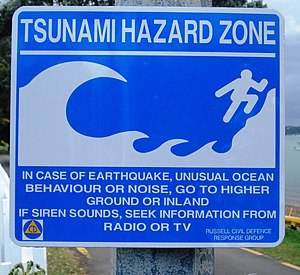
A tsunami is a wave created by underwater disturbance, such as an earthquake (on land or under the water), massive amounts of debris falling into the water (such as a volcanic landslide into the sea), glacier calvings, or being hit by a meteor. The term tsunami is Japanese for "harbour wave".[1]
While some tsunamis are small in height, they can reach great heights and be incredibly destructive when they come into shore and inland. When smashing into the coastal area, they can carry enormously destructive power. Some land areas are more vulnerable than others due to the geological formations of the land, such as harbours which cause the water to slosh around as if in a bathtub.
A tsunami is not one wave but a series of waves. Thus, even though one or two waves may have hit already, it is not safe to assume that the tsunami has ended until the authorities have given the all-clear, as more waves may be coming through.
See also
- Tsunamis - The Are You Ready? guide